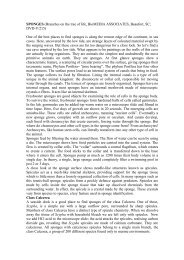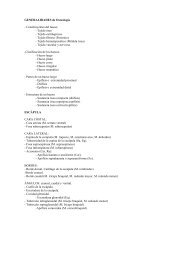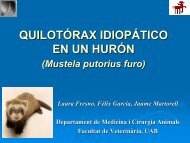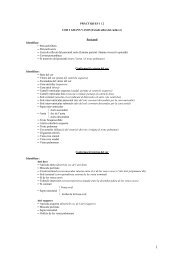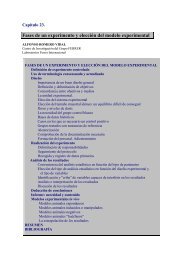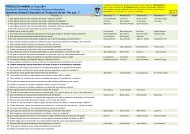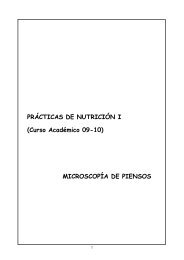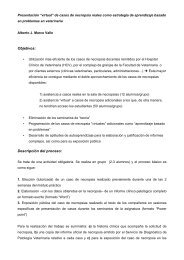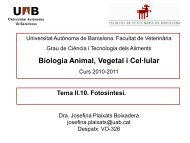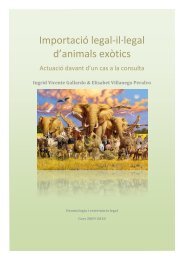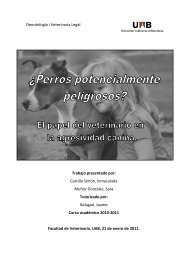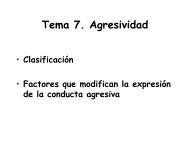Equine castration: review of anatomy, approaches, techniques and ...
Equine castration: review of anatomy, approaches, techniques and ...
Equine castration: review of anatomy, approaches, techniques and ...
You also want an ePaper? Increase the reach of your titles
YUMPU automatically turns print PDFs into web optimized ePapers that Google loves.
Clinical<br />
428<br />
Australian<br />
V E T E R I N A RY<br />
JO U R N A L<br />
C L I N I C A L S E C T I O N<br />
EDITOR<br />
DAVID WATSON<br />
ADVISORY COMMITTEE<br />
AVIAN<br />
LUCIO FILIPPICH<br />
EQUINE<br />
DAVID HODGSON<br />
OPHTHALMOLOGY<br />
JEFF SMITH<br />
PRODUCTION ANIMALS<br />
JAKOB MALMO<br />
SMALL ANIMALS<br />
JILL MADDISON<br />
SURGERY<br />
GEOFF ROBINS<br />
ZOO/EXOTIC ANIMALS<br />
LARRY VOGELNEST<br />
EDITORIAL ADMINISTRATION AND<br />
DESKTOP PUBLISHING<br />
ANNA GALLO<br />
CONTRIBUTIONS INVITED<br />
Practising veterinarians <strong>and</strong> others are invited<br />
to contribute clinical articles to the Australian<br />
Veterinary Journal. We will consider material<br />
in a variety <strong>of</strong> formats, including clinically<br />
orientated <strong>review</strong>s, reports <strong>of</strong> case series,<br />
individual case studies, diagnostic exercises,<br />
<strong>and</strong> letters containing comments or queries.<br />
Practitioners are also invited to contribute to<br />
the case notes feature, where accepted arti-<br />
cles are not peer <strong>review</strong>ed but are edited for<br />
publication. Contributors should consult<br />
instructions to authors <strong>and</strong> recent issues <strong>of</strong><br />
the journal for guidelines as to formatting.<br />
Over referencing should be avoided: authors<br />
should preferably quote only those articles<br />
they feel are most likely to be <strong>of</strong> interest <strong>and</strong><br />
benefit to readers.<br />
Send all contributions to:<br />
Editor, AVJ Clinical Section<br />
AVA House, 272 Brunswick Road,<br />
Brunswick, Vic. 3056,<br />
phone: (03) 9387 2982<br />
fax: (03) 9388 0112<br />
email: avjsc@ava.com.au.<br />
<strong>Equine</strong> <strong>castration</strong>: <strong>review</strong> <strong>of</strong><br />
<strong>anatomy</strong>, <strong>approaches</strong>, <strong>techniques</strong><br />
<strong>and</strong> complications in normal,<br />
cryptorchid <strong>and</strong> monorchid horses<br />
D SEARLE, AJ DART, CM DART <strong>and</strong> DR HODGSON<br />
University Veterinary Centre, Department <strong>of</strong> Veterinary Clinical Sciences, The University<br />
<strong>of</strong> Sydney, Werombi Road, Camden, New South Wales 2570<br />
Complications associated with equine <strong>castration</strong> are the most common cause <strong>of</strong><br />
malpractice claims against equine practitioners in North America. An underst<strong>and</strong>ing<br />
<strong>of</strong> the embryological development <strong>and</strong> surgical <strong>anatomy</strong> is essential to differentiate<br />
abnormal from normal structures <strong>and</strong> to minimise complications. Castration <strong>of</strong><br />
the normal horse can be performed using sedation <strong>and</strong> regional anaesthesia while<br />
the horse is st<strong>and</strong>ing, or under general anaesthesia when it is recumbent.Castration<br />
<strong>of</strong> cryptorchid horses is best performed under general anaesthesia at a surgical<br />
facility. Techniques for <strong>castration</strong> include open, closed <strong>and</strong> half-closed <strong>techniques</strong>.<br />
Failure <strong>of</strong> left <strong>and</strong> right testicles to descend occurs with nearly equal frequency,<br />
however, the left testicle is found in the abdomen in 75% <strong>of</strong> cryptorchid<br />
horses compared to 42% <strong>of</strong> right testicles. Bilateral cryptorchid <strong>and</strong> monorchid<br />
horses are uncommon. Surgical <strong>approaches</strong> described for the <strong>castration</strong> <strong>of</strong> cryptorchid<br />
horses include an inguinal approach with or without retrieval <strong>of</strong> the scrotal<br />
ligament, a parainguinal approach, or less commonly a suprapubic paramedian or<br />
flank approach. Laparoscopic <strong>castration</strong> <strong>of</strong> cryptorchid horses has recently been<br />
described but the technique has limited application in practice at this time. A definitive<br />
diagnosis <strong>of</strong> monorchidism can only be made after surgical exploration <strong>of</strong> the<br />
abdomen, removal <strong>of</strong> the normal testis <strong>and</strong> hormonal testing. Hormonal assays<br />
reported to be useful include analysis <strong>of</strong> basal plasma or serum testosterone or<br />
oestrone sulphate concentrations, testosterone concentrations following hCG stimulation,<br />
<strong>and</strong> faecal oestrone sulphate concentrations. Reported complications <strong>of</strong><br />
<strong>castration</strong> include postoperative swelling, excessive haemorrhage, eventration,<br />
f u n i c u l i t i s, peri t o n i t i s, hy d r o c e l e, penile damage <strong>and</strong> continued stallion-like<br />
behaviour.<br />
Aust Vet J 1999;77:428-434<br />
Key words: Horse, equine, <strong>castration</strong>, cryptorchid, monorchid.<br />
Castration is one <strong>of</strong> the most<br />
common surgical pro c e d u re s<br />
performed in equine practice. 1,2<br />
Although the pro c e d u re is considere d<br />
routine, surgical complications constitute<br />
the most common cause <strong>of</strong><br />
malpractice claims against equine practitioners<br />
in North America. 3 A complete<br />
underst<strong>and</strong>ing <strong>of</strong> male re p ro d u c t i ve<br />
<strong>anatomy</strong> <strong>and</strong> physiology <strong>and</strong> good<br />
surgical technique will reduce the rate<br />
<strong>of</strong> surgical complications. Pre s u r g i c a l<br />
e valuation <strong>and</strong> surgical approach to<br />
cryptorchid <strong>and</strong> monorchid horses are a<br />
m o re complex diagnostic <strong>and</strong> surgical<br />
challenge. This article provides practitioners<br />
with a re v i ew <strong>of</strong> re l e vant information<br />
on the embryological deve l o p-<br />
IM Intramuscularly<br />
IV Intravenously<br />
ment <strong>and</strong> anatomical features <strong>of</strong> the<br />
male equine re p ro d u c t i ve tract, the<br />
<strong>approaches</strong> to <strong>castration</strong> <strong>of</strong> the normal,<br />
cryptorchid, <strong>and</strong> monorchid horse, <strong>and</strong><br />
the diagnosis <strong>and</strong> management <strong>of</strong><br />
surgical complications.<br />
Embryonic development <strong>and</strong><br />
surgical <strong>anatomy</strong> <strong>of</strong> the equine<br />
testis<br />
The embryonic gonad differe n t i a t e s<br />
into a testis at approximately 5 1 ⁄2 we e k s<br />
<strong>of</strong> gestation, at which time it lies on the<br />
ventral aspect <strong>of</strong> the mesonephric<br />
k i d n e y. 4,5 A re t roperitoneal cord <strong>of</strong><br />
mesenchyme coursing across the<br />
abdominal cavity from the caudal pole<br />
<strong>of</strong> the testis to an extraperitoneal position<br />
at the site <strong>of</strong> the future scro t u m<br />
forms the gubernaculum. 5 The gubernaculum<br />
is divided into two parts by<br />
the mesonephric duct which ultimately<br />
Aust Vet J Vol 77, No 7, July 1999
d i f f e rentiates into the epididymis. 4 At<br />
day 45 a peritoneal outpouching at the<br />
site <strong>of</strong> the future internal inguinal ring<br />
i n vades the extraperitoneal segment <strong>of</strong><br />
the gubernaculum forming the va g i n a l<br />
p ro c e s s . 5 Ul t i m a t e l y, when it is<br />
completely differentiated, the gubernaculum<br />
can be divided into the thre e<br />
different segments identified in the adult<br />
horse: the proper ligament <strong>of</strong> the testis<br />
lies between the caudal pole <strong>of</strong> the<br />
m a t u re testis <strong>and</strong> the tail <strong>of</strong> the<br />
epididymis, the ligament <strong>of</strong> the tail <strong>of</strong><br />
the epididymis lies between the tail <strong>of</strong><br />
the epididymis <strong>and</strong> the parietal tunic <strong>of</strong><br />
the vaginal process, <strong>and</strong> the scrotal ligament<br />
lies between the parietal tunic <strong>of</strong><br />
the vaginal process <strong>and</strong> the scro t u m<br />
(Figure 1). 5<br />
At approximately 6 weeks gestation,<br />
the interstitial cells <strong>of</strong> the testis begin to<br />
m u l t i p l y. By 5 months the embryo n i c<br />
testicle <strong>approaches</strong> the size <strong>of</strong> that <strong>of</strong> a<br />
m a t u re stallion <strong>and</strong> lies in contact with<br />
the kidney <strong>and</strong> the internal inguinal<br />
r i n g . 4 , 5 Be t ween 7 <strong>and</strong> 10 months <strong>of</strong><br />
gestation the testicle atrophies to<br />
a p p roximately one tenth <strong>of</strong> its former<br />
s i ze as the gubernaculum short e n s .<br />
4 , 5<br />
The epididymis <strong>and</strong> the ligament <strong>of</strong> the<br />
tail <strong>of</strong> the epididymis exp<strong>and</strong> to dilate<br />
the vaginal ring <strong>and</strong> inguinal canal. 5<br />
Ultimately, at 9 <strong>and</strong> 10 months <strong>of</strong> gestation<br />
dilation <strong>of</strong> the inguinal ring,<br />
contraction <strong>of</strong> the gubernaculum <strong>and</strong><br />
i n c rease in intra-abdominal pre s s u re<br />
combine to force the small, flaccid<br />
testicle into the inguinal ring. 5 T h e<br />
volume <strong>of</strong> extra-abdominal gubernaculum<br />
pre vents the testicle fro m<br />
descending completely into the scrotum,<br />
so at birth the testicles usually lie within<br />
the inguinal rings. 4,5 The mass <strong>of</strong> gubernaculum<br />
is quite large at birth <strong>and</strong> may<br />
be mistaken for a testicle. 5 During the<br />
first few weeks <strong>of</strong> life vaginal rings<br />
contract to approximately 1 cm in diameter<br />
<strong>and</strong> gubernacular tissues reduce in<br />
s i ze, allowing the testicle to assume a<br />
scrotal position. 4,5<br />
The testicular tissue is encased in the<br />
tunica albuginea. 2,5 In the horse the left<br />
testicle is usually larger than the right<br />
<strong>and</strong> is suspended more ventrally <strong>and</strong><br />
situated more caudally. 5 The head <strong>of</strong> the<br />
epididymis is found cranially continuing<br />
as the body <strong>and</strong> tail to become the<br />
ductus deferens caudally. 5 The testicles<br />
lie within an outpocket <strong>of</strong> abdominal<br />
p e r i t o n e u m<br />
k n own as the<br />
tunica va g in<br />
a l i s . 2 , 5 T h e<br />
tunica va g i n a l i s<br />
consists <strong>of</strong><br />
visceral <strong>and</strong> parietal<br />
tunics. T h e<br />
visceral tunic is<br />
tightly adhere d<br />
to the testicle,<br />
ducts <strong>and</strong> vessels,<br />
<strong>and</strong> the parietal<br />
tunic is continuous<br />
with the<br />
parietal peritoneum<br />
(Figure 1). 5<br />
The cre m a s t e r<br />
muscle is a<br />
c a u d o l a t e r a l<br />
extension <strong>of</strong> the<br />
internal abdominal<br />
oblique<br />
muscle <strong>and</strong> is<br />
continuous with<br />
the parietal laye r<br />
<strong>of</strong> the tunica<br />
v a g i n a l i s<br />
i n s e rting at the<br />
caudal pole <strong>of</strong> the<br />
testicle (Fi g u re<br />
2 ) . 5 The parietal<br />
tunic is intimately<br />
adhere n t<br />
to the scrotal skin<br />
t h rough the<br />
s c rotal fascia <strong>and</strong><br />
tunica dart o s<br />
m u s c l e . 2 , 5 T h e<br />
tunica dart o s<br />
sends a sagittal<br />
septum into the<br />
s c rotal sac<br />
dividing it into left <strong>and</strong> right pouches. 5<br />
The spermatic cord courses fro m<br />
abdomen to scrotum through the<br />
inguinal canal which is bounded by deep<br />
<strong>and</strong> superficial inguinal rings. The deep<br />
inguinal ring is a dilatable opening<br />
b e t ween internal abdominal oblique<br />
muscle, rectus abdominus muscle,<br />
prepubic tendon <strong>and</strong> inguinal ligament.<br />
The superficial inguinal ring is formed<br />
by a small opening in the external<br />
abdominal oblique muscle.<br />
Preoperative considerations<br />
Be f o re <strong>castration</strong> all horses should<br />
undergo physical examination including<br />
Clinical<br />
Figure 1.The testicular structures seen during <strong>castration</strong> <strong>of</strong> the<br />
mature male horse using an open <strong>castration</strong> tech n i q u e. T h e<br />
testicle (t) is tightly enclosed in the tunica albuginea.The head <strong>of</strong><br />
the epididymis (a) continues as the body (b) <strong>and</strong> the tail (c) the<br />
latter continues as the vas deferens (d).The tail <strong>of</strong> the epididymis<br />
is attached to the caudal pole <strong>of</strong> the testis by the proper ligament<br />
<strong>of</strong> the testis (e).This continues as the ligament <strong>of</strong> the tail <strong>of</strong> the<br />
epididymis (f) between the tail <strong>of</strong> the epididymis <strong>and</strong> the parietal<br />
tunic (pt).The visceral tunic cov e rs the visceral surface <strong>of</strong> the<br />
t e s t i cl e, e p i d i dy m i s , spermatic vessels (sv), <strong>and</strong> vas defe r e n s .<br />
The parietal tunic <strong>and</strong> cremaster muscle (cm) have been incised<br />
<strong>and</strong> are partially retracted.<br />
external examination <strong>of</strong> the reproductive<br />
t r a c t . 5 Sedation may be re q u i red to<br />
palpate the scrotum <strong>and</strong> the inguinal<br />
canals for the presence <strong>of</strong> two testicles<br />
<strong>and</strong> absence <strong>of</strong> an inguinal hernia.<br />
Tetanus prophylaxis should be curre n t .<br />
Some practitioners choose to give<br />
p rocaine penicillin (20 mg/kg IM)<br />
p rophylactically prior to surgery. T h e<br />
efficacy <strong>of</strong> this in reducing postoperative<br />
complications in <strong>castration</strong> <strong>of</strong> normal<br />
horses is questionable. The use <strong>of</strong><br />
a n t i m i c robials for horses undergoing<br />
c ry p t o rchid or monorchid <strong>castration</strong><br />
should be considered on a case-by - c a s e<br />
basis but cannot be a substitute for<br />
aseptic technique. Preoperative adminis-<br />
Aust Vet J Vol 77, No 7, July 1999 429
Clinical<br />
Figure 2.The testicular structures seen during <strong>castration</strong> <strong>of</strong> the<br />
adult male horse using a closed tech n i q u e.The testicle (t) <strong>and</strong><br />
the tail <strong>of</strong> the epididymis (c) are outlined within the parietal tunic<br />
(pt).The cremaster muscle (cm) can be seen fanning out to insert<br />
towards the caudal pole <strong>of</strong> the testis (cp).The scrotal fascia (sf)<br />
remaining after the testicle <strong>and</strong> cord have been stripped can still<br />
be seen.<br />
tration <strong>of</strong> a nonsteroidal anti-inflammat<br />
o ry drug (phenylbutazone 2.2 to 4.4<br />
mg/kg or flunixin meglumine 1 mg/kg),<br />
<strong>and</strong> postoperative administration as<br />
required, may help control postoperative<br />
pain <strong>and</strong> swelling.<br />
Castration can be performed in the<br />
st<strong>and</strong>ing sedated horse using re g i o n a l<br />
anaesthesia or with the horse under<br />
general anaesthesia. The choice is largely<br />
based on the surgeon’s pre f e rence <strong>and</strong><br />
experience. Docile colts whose genitals<br />
can be palpated readily without sedation<br />
a re usually the safest c<strong>and</strong>idates for<br />
st<strong>and</strong>ing <strong>castration</strong>. 5<br />
Sedation <strong>and</strong> anaesthesia for cas -<br />
tration<br />
St<strong>and</strong>ing <strong>castration</strong><br />
A combination <strong>of</strong> physical <strong>and</strong> chemical<br />
restraint <strong>and</strong> regional anaesthesia is<br />
generally re c o m m e n d e d . 2 Drugs used<br />
c o m m o n l y, alone or in combination,<br />
include acepromazine, xylazine<br />
h yd rochloride, romifidine, detomidine<br />
hydrochloride <strong>and</strong> butorphanol tartrate.<br />
A combination <strong>of</strong> detomidine<br />
h yd rochloride (20 to 40 μg/kg) or<br />
xylazine hyd rochloride (0.3 to 0.5<br />
mg/kg) <strong>and</strong> butorphanol tartrate (0.01<br />
to 0.05 mg/kg) provides reliable sedation<br />
<strong>and</strong> analgesia. 6<br />
430<br />
Various re g i o n a l<br />
anaesthetic <strong>techniques</strong><br />
have been<br />
d e s cribed for <strong>castration</strong><br />
<strong>of</strong> the st<strong>and</strong>ing<br />
ho r s e . 2,5,6 L o c a l<br />
a naes-thetic can be<br />
injected into the<br />
spermatic cord ,<br />
t e s t i c u l a r<br />
p a renchyma, or<br />
both. The testicular<br />
n e rves may be<br />
anaesthetised by<br />
d i rectly injecting<br />
15 to 30 mL <strong>of</strong><br />
local anaesthetic<br />
into the sp e r m a t i c<br />
c o rd using a 21gauge<br />
1.5 inch<br />
needle. This can be<br />
achieved by placing<br />
gentle traction on<br />
the testicle allowing<br />
access to the spermatic<br />
cord or by<br />
depositing the local<br />
anaesthetic at the<br />
l e vel <strong>of</strong> the superficial inguinal ring. 2<br />
Infiltration <strong>of</strong> the spermatic cord may<br />
occasionally cause a haematoma which<br />
can interf e re with application <strong>of</strong> the<br />
e m a s c u l a t o r. 5 When injecting into the<br />
testicular parenchyma, the testis is<br />
tensed in the fundus <strong>of</strong> the scrotum <strong>and</strong><br />
15 to 25 mL <strong>of</strong> local anaesthetic is<br />
injected into the parenchyma <strong>of</strong> each<br />
testis using a 18-gauge 1.5 inch needle.<br />
Gi ven sufficient time the local anaesthetic<br />
is proposed to diffuse from the<br />
pampiniform plexus to anaesthetise the<br />
c o rd . 2 When combining both <strong>techniques</strong>,<br />
infiltration <strong>of</strong> the testicle first<br />
can facilitate access to the cord in<br />
anxious horses. In our h<strong>and</strong>s this combination<br />
provides reliable anaesthesia for<br />
most horses. Using either technique, 5<br />
to 10 mL <strong>of</strong> local anaesthetic should be<br />
deposited under the scrotal skin either<br />
side <strong>of</strong> the median raphe along the<br />
proposed incision line. 2<br />
Recumbent <strong>castration</strong><br />
We prefer to use general anaesthesia<br />
because surgical exposure is improve d<br />
<strong>and</strong> it carries less risk for surgeon <strong>and</strong><br />
patient. Various drugs <strong>and</strong> drug combinations<br />
have been recommended for this<br />
procedure. 2,5 The placement <strong>of</strong> a jugular<br />
catheter is warranted for drug adminis-<br />
tration. Thiobarbiturates (thiopentone<br />
sodium 4 to 8 mg/kg IV to effect)<br />
a d m i n i s t e red following sedation with<br />
xylazine hyd rochloride (0.3 to 0.5<br />
mg/kg IV) or acepromazine (0.03 to<br />
0.05 mg/kg IV), or given with or after<br />
muscle relaxants such as guaifenesin<br />
(100 mg/kg IV to effect) have been<br />
recommended for short anaesthetic<br />
p ro c e d u re s . 2 While these combinations<br />
p rovide excellent muscle relaxation <strong>and</strong><br />
analgesia, anaesthetic re c ove ry may be<br />
c o n s i d e red less than satisfactory if<br />
repeated administration <strong>of</strong> the barbiturate<br />
is required. 2,5<br />
Xylazine hyd rochloride (1.1 mg/kg<br />
IV) followed by ketamine hydrochloride<br />
(2.2 mg/kg IV) combined with<br />
d i a zepam (0.05 to 0.1mg/kg IV) is an<br />
e f f e c t i ve combination. 2 , 5 Di a ze p a m<br />
p rovides muscle relaxation <strong>and</strong> appears<br />
to improve the quality <strong>of</strong> anaesthetic<br />
induction <strong>and</strong> recovery. The addition <strong>of</strong><br />
butorphanol tartrate (0.02 to 0.03<br />
mg/kg IV) will provide additional analgesia<br />
<strong>and</strong> may improve anaesthetic<br />
re c ove ry. This combination generally<br />
a l l ows at least 12 to 15 min <strong>of</strong> surgical<br />
time. Additional doses <strong>of</strong> xylazine (0.25<br />
mg/kg IV) <strong>and</strong> ketamine (0.5 mg/kg IV)<br />
can be used safely to extend surgical<br />
anaesthesia.<br />
Cryptorchid <strong>castration</strong><br />
Unless the position <strong>of</strong> the nondescended<br />
testicle can be accurately<br />
determined <strong>and</strong> is easily accessible, this<br />
s u r g e ry is best performed at a surgical<br />
centre under gaseous anaesthesia. 3,5<br />
Surgical <strong>techniques</strong> for <strong>castration</strong><br />
<strong>of</strong> normal horses<br />
Surgical re m oval <strong>of</strong> the descended<br />
testis can be performed using an open<br />
or closed technique. T h e re is also a va r iation<br />
on the closed technique re f e r re d<br />
to as half-closed or semi-closed castrat<br />
i o n . 2,5 T h e re are several modifications<br />
<strong>of</strong> each technique but, re g a rdless <strong>of</strong><br />
whether the horse is sedated <strong>and</strong><br />
st<strong>and</strong>ing or recumbent <strong>and</strong> anaesthetised,<br />
the surgical principles for<br />
<strong>castration</strong> remain the same. . 2 , 5 Tr a d it<br />
i o n a l l y, <strong>castration</strong> <strong>techniques</strong> allow for<br />
second intention healing <strong>of</strong> scro t a l<br />
wounds, howe ver some have advo c a t e d<br />
p r i m a ry closure . 7,8 Pr i m a ry closure is<br />
r a rely suited for <strong>castration</strong>s perf o r m e d<br />
in the field but may be <strong>of</strong> benefit in<br />
select cases where <strong>castration</strong> is<br />
Aust Vet J Vol 77, No 7, July 1999
p e rformed aseptically in a surgical<br />
facility. Reported advantages <strong>of</strong> primary<br />
c l o s u re include early return to work ,<br />
minimal postoperative management <strong>and</strong><br />
a more favourable <strong>and</strong> early cosmetic<br />
outcome with no possibility <strong>of</strong> eve n t r ation.<br />
7<br />
Open technique<br />
Two incisions are made through the<br />
s c rotal skin, tunica dartos, scrotal fascia<br />
<strong>and</strong> parietal tunic parallel to the median<br />
raphe, approximately 2 cm apart <strong>and</strong> 8<br />
to 10 cm long. The testis is pro l a p s e d<br />
out <strong>of</strong> the tunic but remains attached to<br />
the parietal tunic by the ligament <strong>of</strong> the<br />
epididymis (Figure 1). This ligament can<br />
be transected to release the parietal tunic<br />
<strong>and</strong> cremaster muscle <strong>and</strong> expose the<br />
vessels <strong>and</strong> ductus deferens which can<br />
then be emasculated. To reduce the<br />
o c c u r rence <strong>of</strong> postoperative complications<br />
such as scirrhous cord <strong>and</strong> hyd rocele,<br />
it is desirable to digitally strip the<br />
fascia around the parietal tunic as far<br />
p roximal as possible so it may be emasculated<br />
<strong>and</strong> re m ove d . 2 , 5 This is easily<br />
a c h i e ved if the parietal tunic alone (not<br />
the parietal tunic <strong>and</strong> testicle together) is<br />
pulled distally with Carmalt forc e p s<br />
while the fascia is stripped prox i m a l l y<br />
using gauze swabs. Alternatively the<br />
parietal tunic, the cremaster muscle, the<br />
vessels <strong>and</strong> the ductus deferens can all be<br />
emasculated together.<br />
Closed technique<br />
Incisions similar to those for the open<br />
technique are made down to but not<br />
t h rough the parietal tunic (Fi g u re 2).<br />
The testicle, still encapsulated by the<br />
tunic, is grasped <strong>and</strong> the scrotal fascia is<br />
stripped from the parietal tunic using a<br />
dry swab, until the cremaster muscle <strong>and</strong><br />
the parietal tunic are clearly exposed.<br />
The entire spermatic cord is then emasculated.<br />
2,5<br />
Half-closed technique<br />
The approach is similar to the closed<br />
technique, howe ver after the parietal<br />
tunic <strong>and</strong> the cremaster muscle are<br />
exposed a 2 to 3 cm ve rtical incision is<br />
made through the parietal tunic just<br />
p roximal to the testicle. The inside <strong>of</strong><br />
the parietal tunic is inspected to ensure<br />
t h e re is no evidence <strong>of</strong> herniated intestine<br />
<strong>and</strong> the entire spermatic cord is<br />
emasculated prox i m a l l y. Alternative l y<br />
the vessels <strong>and</strong> ductus can be exteriorised<br />
from the parietal tunic <strong>and</strong> emas-<br />
culated before emasculating the parietal<br />
tunic <strong>and</strong> cremaster muscle. In another<br />
modification the surgeon’s thumb can be<br />
placed through the incision made in the<br />
parietal tunic <strong>and</strong> the fingers used to<br />
p rolapse the testicle, vessels <strong>and</strong> ductus<br />
d e f e rens through the incision. T h i s<br />
p rovides the surgeon with a secure grip<br />
on the parietal tunic. The vessels <strong>and</strong><br />
ductus deferens can then be emasculated<br />
separately prior to emasculation <strong>of</strong> the<br />
parietal tunic <strong>and</strong> cremaster muscle or<br />
the cord can be emasculated in one. 5<br />
Cryptorchid <strong>castration</strong><br />
The failure <strong>of</strong> the right <strong>and</strong> left testicle<br />
to descend occurs with nearly equal<br />
frequency. 9,10 Of left testicles that fail to<br />
descend 75% are found within the<br />
abdomen compared to 42% <strong>of</strong> right<br />
t e s t i c l e s . 1 0 Fa i l u re <strong>of</strong> both testicles to<br />
descend is uncommon, affecting 9 to<br />
14% <strong>of</strong> cryptorchid horses. 5,10<br />
An accurate <strong>castration</strong> history is<br />
helpful in determining the surgical<br />
a p p roach to the cry p t o rchid horse.<br />
Clinical<br />
Aust Vet J Vol 77, No 7, July 1999 431<br />
5 , 1 1<br />
Palpation <strong>of</strong> the scrotum <strong>and</strong> inguinal<br />
rings for presence <strong>of</strong> testicular structures<br />
may require sedation in younger or more<br />
anxious colts. 5 Tr a n s rectal examination<br />
generally contributes little to differe n t iating<br />
the type <strong>of</strong> cryptorchid <strong>and</strong> carries<br />
i n h e rent risks in younger or more fractious<br />
animals. 5,11<br />
Surgical options include inguinal,<br />
parainguinal, suprapubic paramedian<br />
<strong>and</strong> flank appro a c h e s. 2 , 5 Mo re re c e n t l y,<br />
st<strong>and</strong>ing <strong>and</strong> recumbent cry p t o rc h i d e ctomy<br />
using a laparoscopic technique<br />
have been described. 12,13<br />
Inguinal approach<br />
Two <strong>approaches</strong> are described for<br />
inguinal exploration. 5,11 A 10 cm inci-<br />
Surgical <strong>approaches</strong> for cryptorchid<br />
horses<br />
Inguinal<br />
Parainguinal<br />
Suprapubic paramedian<br />
Flank<br />
Laparoscopic<br />
sion is made through the scrotal skin<br />
w h e re the testicle should be <strong>and</strong> digital<br />
dissection is continued tow a rds the<br />
s u p e rficial inguinal ring. 5 A l t e r n a t i ve l y,<br />
a 8 to 15 cm incision can be made<br />
d i rectly over the superficial inguinal<br />
r i n g . 1 1 A scrotal incision results in less<br />
skin haemorrhage <strong>and</strong> precludes the<br />
need to displace inguinal fat to locate<br />
the superficial inguinal ring. 11 Re c o g n ition<br />
<strong>of</strong> anato-mical features is improved<br />
if haemorrhage is controlled. Du r i n g<br />
dissection down to the inguinal ring the<br />
smooth, white parietal tunic <strong>of</strong> the<br />
vaginal process is sought. If no structures<br />
a re identified the inguinal extension <strong>of</strong><br />
the gubernaculum testis (scrotal ligament)<br />
can <strong>of</strong>ten be identified exiting<br />
from the superficial inguinal ring. It is a<br />
thin, flat, fibrous b<strong>and</strong> that courses from<br />
the vaginal process to the scrotum. It can<br />
be located by carefully inspecting the<br />
lateral or medial margins <strong>of</strong> the cranial<br />
t h i rd <strong>of</strong> the superficial inguinal ring.<br />
Gentle traction on this ligament using<br />
sponge forceps will eve rt the va g i n a l<br />
p rocess from the superficial inguinal<br />
ring <strong>and</strong> it can be opened longitudinally<br />
using scissors. Commonly the tail <strong>of</strong> the<br />
epididymis is the first stru c t u re identified<br />
<strong>and</strong> gentle traction on the<br />
epididymis will expose the ductus<br />
d e f e rens, the proper ligament <strong>of</strong> the<br />
testis, <strong>and</strong> finally the testis.<br />
If the vaginal ring can accommodate<br />
m o re than the tips <strong>of</strong> the index <strong>and</strong><br />
middle fingers then the inguinal canal<br />
should be packed with sterile gauze for<br />
24 to 36 h or closed with sutures to<br />
reduce the risk <strong>of</strong> intestinal pro l a p s e<br />
t h rough the canal. A sterile gauze<br />
b<strong>and</strong>age can be used as packing to obliterate<br />
the inguinal canal <strong>and</strong> the distal<br />
end is left hanging freely from the<br />
s c rotal wound. The pack is maintained<br />
in the inguinal ring by loosely suturing<br />
skin edges. Alternatively the superf i c i a l<br />
ring can be sutured closed using simple<br />
i n t e r rupted sutures <strong>of</strong> heavy absorbable<br />
suture material.<br />
Parainguinal approach<br />
W h e re the testis cannot be exteriorised<br />
from the inguinal canal using<br />
n o n i n va s i ve inguinal appro a c h e s ,<br />
s e veral more inva s i ve <strong>techniques</strong> have<br />
been described to explore the inguinal<br />
c a n a l . 5 , 1 1 These have been used<br />
commonly but it has been suggested<br />
that they increase the risk <strong>of</strong> eviscerat<br />
i o n . 10,11 The parainguinal appro a c h<br />
p rovides a convenient alternative where<br />
the noninva s i ve inguinal appro a c h e s<br />
1 4<br />
1 0
Clinical<br />
h a ve been unsuccessful. 15 A 4 cm incision<br />
is made in the aponeurosis <strong>of</strong> the<br />
external abdominal oblique muscle 1 to<br />
2 cm medial <strong>and</strong> parallel to the superficial<br />
inguinal ring. The incision is<br />
c e n t red over the cranial aspect <strong>of</strong> the<br />
ring. The internal abdominal oblique<br />
muscle underlying the aponeurosis is<br />
bluntly separated along its muscle fibres<br />
to expose the peritoneum which is then<br />
penetrated to enter the abdominal<br />
cavity. The internal inguinal ring can be<br />
identified caudolaterally <strong>and</strong>, with a<br />
sweeping action, the fingers should pick<br />
up any testicular stru c t u res. These can<br />
be exteriorised <strong>and</strong> emasculated. If difficulty<br />
is encountered in locating the<br />
epididymis or associated stru c t u res the<br />
incision can be enlarged to allow the<br />
s u r g e o n’s h<strong>and</strong> to enter the abdominal<br />
cavity for exploration <strong>of</strong> the uro g e n i t a l<br />
tract. The incision in the aponeurosis is<br />
closed using heavy absorbable suture s<br />
<strong>and</strong> the subcutaneous tissue <strong>and</strong> skin<br />
can be closed or left open to heal by<br />
second intention. 15<br />
Suprapubic paramedian approach<br />
An incision <strong>of</strong> 8 to 15 cm is made<br />
cranially from the level <strong>of</strong> the pre p u t i a l<br />
orifice approximately 5 to 10 cm lateral<br />
to the ventral midline. 5 , 1 6 The abdominal<br />
tunic, which is closely adherent to<br />
the ventral sheath <strong>of</strong> the rectus abdominis<br />
muscle, is incised longitudinally<br />
<strong>and</strong> the underlying fibres <strong>of</strong> the re c t u s<br />
abdominis muscle are bluntly separated<br />
in the same direction. Blunt dissection is<br />
used to penetrate through the dorsal<br />
rectus sheath, re t roperitoneal fat <strong>and</strong><br />
peritoneum. The testicle is usually<br />
found near the deep inguinal ring <strong>and</strong> is<br />
easily exteriorised. After emasculation,<br />
the abdominal tunic, the subcutis <strong>and</strong><br />
skin are each closed separately with<br />
i n t e r rupted or continuous sutures. T h i s<br />
p ro c e d u re has largely been superseded<br />
by the parainguinal approach, howe ve r<br />
it is proposed to allow access to both<br />
testicles in the case <strong>of</strong> a bilateral cry ptorchid.<br />
5<br />
Flank approach<br />
A st<strong>and</strong>ard flank approach can be used<br />
in st<strong>and</strong>ing or recumbent horses. 17 T h e<br />
testicle is located <strong>and</strong> re m oved using a<br />
similar technique to the paramedian<br />
a p p roach. This technique is less acceptable<br />
cosmetically than the other<br />
<strong>approaches</strong> <strong>and</strong> is now generally reserved<br />
for removal <strong>of</strong> large neoplastic testicles. 5<br />
432<br />
Laparoscopy<br />
Laparoscopic <strong>techniques</strong> for <strong>castration</strong><br />
<strong>of</strong> cryptorchid horses have recently been<br />
d e s c r i b e d . 1 2 , 1 3 L a p a roscopy re q u i re s<br />
special instruments not readily ava i l a b l e<br />
in general practice 5 <strong>and</strong> further re f i n ements<br />
are needed in the method. 13 At<br />
present this technique has limited application<br />
in general practice but it may be<br />
more feasible in the future. 5<br />
Monorchidism<br />
Mo n o rchidism is the complete<br />
absence <strong>of</strong> one testicle <strong>and</strong> is rare in the<br />
h o r s e . 5 A definitive diagnosis can only<br />
be made after surgical exploration <strong>of</strong> the<br />
abdomen, re m oval <strong>of</strong> the other testis<br />
<strong>and</strong> hormonal testing. 1 8 , 1 9 Us e f u l<br />
hormonal assays include basal plasma or<br />
s e rum testosterone <strong>and</strong> oestro n e<br />
sulphate concentrations, testostero n e<br />
concentrations following hCG stimulation,<br />
<strong>and</strong> faecal oestrone sulphate<br />
c o n c e n t r a t i o n . 5,18,19 The hCG stimulation<br />
test in horses older than 18 months,<br />
basal oestrone sulphate assay in horses<br />
older than 3 years or a combination <strong>of</strong><br />
Hormonal assays detecting testicular tissue<br />
Hormone detected Sample<br />
Basal testosterone Serum or plasma<br />
Basal oestrone Serum, plasma or<br />
sulphate faeces<br />
Testosterone following Serum or plasma<br />
hCG stimulation<br />
both tests appear to be most re l ia<br />
b l e . 5 , 1 1 , 1 8 , 1 9 The hCG stimulation test<br />
m e a s u res plasma or serum testostero n e<br />
concentrations, before <strong>and</strong> 1 <strong>and</strong> 24 h<br />
after intravenous administration <strong>of</strong> 6000<br />
to 10,000 IU <strong>of</strong> hCG. 1 8 , 1 9 T h e re should<br />
be no increase above basal testostero n e<br />
concentrations in horses with no testicular<br />
tissue. The response in horses with<br />
testicular tissue may be poor during<br />
winter or if testicular tissue is abdominal.<br />
Both tests should be performed if either<br />
test is inconclusive. Samples should be<br />
submitted to laboratories that ro u t i n e l y<br />
assay equine testosterone <strong>and</strong> oestro n e<br />
sulphate concentrations so that re l i a b l e<br />
re f e rence values are ava i l a b l e . 1 4 , 1 9<br />
Complications <strong>of</strong> <strong>castration</strong><br />
Postoperative swelling<br />
Some preputial <strong>and</strong> scrotal oedema is<br />
normal, usually greatest 3 to 6 days after<br />
s u r g e ry <strong>and</strong> subsiding by 9 days. 2 0<br />
Excessive swelling is a common complication<br />
<strong>and</strong> typically occurs with inadequate<br />
wound drainage, inadequate posto<br />
p e r a t i ve exe rcise, poor lymphatic<br />
drainage, exc e s s i ve surgical trauma or<br />
infection. 1,20<br />
Postoperative swelling can be reduced<br />
by creating a large scrotal incision,<br />
a voiding exc e s s i ve tissue trauma,<br />
re m oving as much tunica vaginalis as<br />
possible, manually stretching the surgical<br />
incision <strong>and</strong> removing the median raphe<br />
during surgery. 5,20 Following <strong>castration</strong>,<br />
exercise, hosing the wound, <strong>and</strong> the use<br />
<strong>of</strong> nonsteroidal anti-inflammatory drugs<br />
can reduce swe l l i n g . 1 , 5 , 2 0 The ow n e r<br />
may start riding the horse 24 to 48 h<br />
after surgery. 20<br />
Exc e s s i ve postoperative swelling is<br />
painful <strong>and</strong> reduces willingness to exe rcise,<br />
causing the wound to seal pre m at<br />
u rely <strong>and</strong> compounding the pro b l e m .<br />
Treatment invo l ves nonsteroidal antiinflammatory<br />
drugs to decrease pain <strong>and</strong><br />
inflammation <strong>and</strong> increase tolerance to<br />
e xe rc i s e . 1 , 5 , 2 0 If scrotal wounds have<br />
closed, it may be beneficial to sedate the<br />
horse <strong>and</strong> reopen the wounds manually<br />
wearing a sterile glove . 1,5,20 This may<br />
need to be repeated on consecutive days<br />
until the swelling reduces. Antimicrobial<br />
d rug treatment may be indicated where<br />
the discharge is purulent. Se c o n d a ry<br />
problems associated with severe swelling<br />
include phimosis, paraphimosis, cellulitis,<br />
wound infection <strong>and</strong> dysuria. 20<br />
Excessive haemorrhage<br />
Haemorrhage may occur during,<br />
immediately after or several days after<br />
s u r g e ry. 2 0 Some bleeding from scro t a l<br />
wounds after <strong>castration</strong> is normal but if<br />
p r<strong>of</strong>use bleeding continues unabated for<br />
m o re than 15 min haemorrhage should<br />
be considered exc e s s i ve . 1 , 5 , 2 0 Exc e s s i ve<br />
haemorrhage generally occurs from the<br />
testicular art e ry, but may originate fro m<br />
traumatic ru p t u re or laceration <strong>of</strong><br />
branches <strong>of</strong> the external pudendal<br />
ve i n . 1 , 2 0 A rterial haemorrhage is generally<br />
a result <strong>of</strong> inadequate crushing by the<br />
emasculators. The emasculators should b e<br />
applied perpendicular to, <strong>and</strong> without<br />
tension on, the spermatic cord with the<br />
cutting blade closest to the testes.<br />
1 , 5 , 2 0<br />
Precise guidelines for when to intervene<br />
surgically are not established but<br />
treatment <strong>of</strong> postoperative haemorrhage<br />
is best performed under general anaes-<br />
Aust Vet J Vol 77, No 7, July 1999
Complications <strong>of</strong> <strong>castration</strong><br />
Postoperative swelling<br />
Excessive haemorrhage<br />
Eventration<br />
Funiculitis<br />
Hydrocele<br />
Penile damage<br />
Continued masculine behaviour<br />
t h e s i a . 1 , 5 , 2 0 Be f o re anaesthesia the<br />
patient should be assessed care f u l l y,<br />
paying particular attention to cardiovascular<br />
status. The site <strong>of</strong> haemorrhage<br />
should be identified. The spermatic cord<br />
may be grasped with long forceps passed<br />
into the inguinal canal <strong>and</strong> the testicular<br />
a rt e ry occluded. The cord can then be<br />
emasculated proximally or ligated. If the<br />
c o rd cannot be ligated or emasculated,<br />
the forceps can be left in place for 12 to<br />
24 h to allow thrombosis to occur.<br />
W h e re the end <strong>of</strong> the cord cannot be<br />
grasped, haemorrhage can usually be<br />
c o n t rolled by packing the scrotum with<br />
g a u ze. If the haemorrhage is occurring<br />
f rom a large superficial vein in the<br />
s c rotal or inguinal area, ligation <strong>of</strong> the<br />
vessel is the treatment <strong>of</strong> choice.<br />
Eventration<br />
Eventration through the vaginal ring<br />
<strong>and</strong> open scrotal incision is uncommon,<br />
generally occurring within 4 h but may<br />
occur up to 6 days after surgery. 21 Eventration<br />
<strong>of</strong> the small intestine makes up<br />
67% <strong>of</strong> cases while omental pro l a p s e<br />
comprises the re m a i n d e r. 2 2 A surv i va l<br />
rate <strong>of</strong> 85 to 100% can be expected<br />
w h e re appropriate treatment is instit<br />
u t e d . 2 2 Suggested predisposing factors<br />
include a pre-existing undetected<br />
inguinal hernia, presence <strong>of</strong> visceral<br />
s t ru c t u res adjacent to the internal<br />
inguinal ring, <strong>and</strong> increased abdominal<br />
p re s s u re following surgery. 2 2 Pa l p a t i o n<br />
<strong>of</strong> the scrotum <strong>and</strong> inguinal regions for<br />
hernias prior to <strong>castration</strong> is re c o mmended<br />
in foals. St a n d a rd b red horses<br />
a re believed to be predisposed to<br />
congenital inguinal herniation. 5<br />
If evisceration occurs the main objective<br />
is to clean <strong>and</strong> protect the intestine<br />
<strong>and</strong> return it to the abdomen before it is<br />
e xc e s s i vely traumatised or contamin<br />
a t e d . 2 1 The intestine should be<br />
p rotected by a moistened towel shaped<br />
into a sling <strong>and</strong> the horse anaesthetised<br />
<strong>and</strong> positioned in dorsal re c u m b e n c y. 2 1<br />
In the field the intestine should be<br />
l a vaged <strong>and</strong> where possible placed back<br />
within the scrotum which is suture d . 2 1<br />
Bro a d s p e c t rum antimicrobial therapy<br />
should be initiated, an analgesic dose <strong>of</strong><br />
flunixin meglumine administered <strong>and</strong><br />
the horse immediately re f e r red to a<br />
surgical facility. To replace the intestines<br />
into the abdomen, dilation <strong>of</strong> the<br />
vaginal ring <strong>and</strong> traction on the<br />
intestines through ventral midline or<br />
parainguinal celiotomy are usually<br />
n e c e s s a ry. 5 , 2 1 The tunic should be<br />
ligated <strong>and</strong> emasculated as far prox imally<br />
as possible <strong>and</strong> the superf i c i a l<br />
inguinal ring closed with large-diameter,<br />
absorbable suture material. 1,5,20 Alternat<br />
i ve l y, the inguinal canal can be packed<br />
with gauze for 24 to 48 h, howe ve r<br />
intestine may still eventrate around the<br />
p a c k i n g . 1,5,21 Prolapse <strong>of</strong> the omentum<br />
through the inguinal ring can usually be<br />
managed using sedation <strong>and</strong> transecting<br />
the prolapsed omentum as far prox imally<br />
as possible. After re c ove ry fro m<br />
anaesthesia the horse should be kept<br />
quiet in a stall for 24 to 48 h. 5,21<br />
Evisceration <strong>of</strong> omentum from the<br />
scrotal wound is much less serious <strong>and</strong> is<br />
best treated with transection <strong>of</strong> the<br />
omentum which can be performed with<br />
the horse st<strong>and</strong>ing. 5<br />
Funiculitis<br />
Funiculitis refers to inflammation <strong>of</strong><br />
the spermatic cord . 1 , 5 , 2 1 It is usually a<br />
septic process developing as an extension<br />
<strong>of</strong> a scrotal infection or from a contaminated<br />
emasculator or ligature. 5 Failure to<br />
remove the tunica vaginalis <strong>and</strong> external<br />
c remaster muscle during open <strong>castration</strong>s<br />
predisposes horses to septic funic<br />
u l i t i s . 2 3 Signs va ry with pyrexia, lameness,<br />
inguinal <strong>and</strong> scrotal swelling <strong>and</strong><br />
c h ronic discharge <strong>of</strong>ten noted. 1 , 5 T h e s e<br />
may not develop for months or ye a r s<br />
after <strong>castration</strong>. 5,21<br />
In the early stages, funiculitis <strong>of</strong>ten<br />
re s o l ves with antimicrobial therapy <strong>and</strong><br />
the establishment <strong>of</strong> drainage, but occasionally<br />
surgical re m oval <strong>of</strong> the infected<br />
stump is re q u i re d . 5 , 2 1 A chronic infection<br />
with pyogenic bacteria is<br />
commonly referred to as scirrhous cord,<br />
h owe ver the term ‘c h a m p i g n o n’ <strong>and</strong><br />
‘ b o t r i o m yc o s i s’ have been used historically<br />
to describe infection with St re p t o -<br />
coccus spp <strong>and</strong> Staphylococcus spp, respec-<br />
Clinical<br />
tively. 5,21 Extension <strong>of</strong> the septic process<br />
t h rough the inguinal ring <strong>and</strong> into the<br />
peritoneal cavity is possible but<br />
u n c o m m o n . 5 Treatment <strong>of</strong> scirrhous<br />
c o rd re q u i res surgical resection <strong>and</strong><br />
a n t i m i c robial therapy. 1 , 5 , 2 0 The horse<br />
should be anaesthetised <strong>and</strong> positioned<br />
in dorsal re c u m b e n c y. The infected<br />
stump is then isolated from healthy<br />
tissue using blunt dissection. The cord is<br />
emasculated proximal to the infected<br />
stump <strong>and</strong> the wound is left to heal by<br />
second intention. 5<br />
Peritonitis<br />
The vaginal <strong>and</strong> peritoneal cavities<br />
communicate <strong>and</strong> nonseptic peritonitis<br />
is common following <strong>castration</strong>.<br />
Aust Vet J Vol 77, No 7, July 1999 433<br />
1 , 5 , 2 1<br />
Haemoperitoneum <strong>and</strong> secondary<br />
inflammation can increase peritoneal<br />
total nucleated cell counts to more than<br />
10 x 10 9 cells/L for at least 5 days with<br />
counts greater than 100 x 10 9 cells/L not<br />
uncommon. 23 Septic peritonitis is rare, 1<br />
but should be considered where signs<br />
include abdominal pain, pyrexia, tachycardia,<br />
diarrhoea, weight loss <strong>and</strong> reluctance<br />
to move . 1 , 5 , 2 1 Toxic or degenerate<br />
n e u t rophils <strong>and</strong> intracellular bacteria<br />
found on abdominocentesis confirm the<br />
d i a g n o s i s . 1 , 5 , 2 1 Cu l t u re <strong>of</strong> a peritoneal<br />
fluid sample is suggested where possible.<br />
Treatment consists <strong>of</strong> appro p r i a t e<br />
a n t i m i c robial <strong>and</strong> nonsteroidal antii<br />
n f l a m m a t o ry therapy, <strong>and</strong> prov i d i n g<br />
analgesia, peritoneal drainage <strong>and</strong><br />
l a vage, <strong>and</strong> adequate drainage thro u g h<br />
the scro t u m . 5 Until culture re s u l t s<br />
become available, procaine penicillin<br />
(20 mg/kg IM twice daily) <strong>and</strong> gentamicin<br />
sulphate (6.6 mg/kg, IV or IM once<br />
daily) should be considered.<br />
Hydrocele<br />
A hyd rocele is an accumulation <strong>of</strong><br />
sterile amber-coloured fluid within the<br />
vaginal tunic. It can appear months to<br />
years following <strong>castration</strong>. 1 , 5 , 2 1 It is<br />
b e l i e ved to result from failure to re s e c t<br />
the vaginal tunic adequately during<br />
<strong>castration</strong> <strong>and</strong> is reported to occur most<br />
commonly in mules. 1 , 5 It appears as a<br />
fluid-filled enlargement <strong>of</strong> the scro t u m<br />
that can <strong>of</strong>ten be reduced by squeez i n g<br />
the fluid into the abdominal cavity.<br />
Treatment is only necessary where the<br />
s welling is unsightly or interf e res with<br />
function. The skin is incised over the sac<br />
<strong>and</strong> the vaginal tunic is isolated prox imally<br />
to the inguinal ring <strong>and</strong> emasculated.<br />
1,5
Clinical<br />
Penile damage<br />
Complications involving the penis are<br />
r a re <strong>and</strong> generally associated with iatrogenic<br />
trauma to the penile shaft. Pe n i l e<br />
p rolapse can occur secondary to exc e ss<br />
i ve swelling, <strong>and</strong> priapism <strong>and</strong> penile<br />
paralysis has been re p o rted follow i n g<br />
administration <strong>of</strong> phenothiazine-derivative<br />
tranquillizers. 1,5,21<br />
Continued masculine behaviour<br />
Castration does not always result in<br />
elimination <strong>of</strong> objectionable stallion-like<br />
b e h a v i o u r. This has been attributed to<br />
incomplete re m oval <strong>of</strong> epididymal<br />
tissue, presence <strong>of</strong> heterotopic testicular<br />
tissue, production <strong>of</strong> high concentrations<br />
<strong>of</strong> <strong>and</strong>rogens from the adre n a l<br />
gl<strong>and</strong>, incomplete cryptorchid <strong>castration</strong><br />
<strong>and</strong> psychological re a s o n s . 1 , 5 A n d ro g e n s<br />
are not produced by the epididymis <strong>and</strong><br />
t h e re f o re the presence or absence <strong>of</strong><br />
epididymal tissue cannot influence<br />
masculine behaviour. Amputating the<br />
spermatic cords was re p o rted to abolish<br />
objectionable masculine behaviour in<br />
75% <strong>of</strong> castrated horses, but no satisfact<br />
o ry explanation was <strong>of</strong>fered for this<br />
re s p o n s e . 24 He t e rotopic testicular tissue<br />
<strong>and</strong> production <strong>of</strong> adrenal <strong>and</strong>ro g e n s<br />
h a ve never been established in horses<br />
<strong>and</strong> are unlikely to be the cause <strong>of</strong><br />
continued stallion-like behaviour.<br />
434<br />
1 , 5<br />
About 20 to 30% <strong>of</strong> horses display some<br />
masculine behaviour following castra-<br />
Erysipelas in malleefowl<br />
tion. 3,26 It is likely that this is psychological<br />
in origin <strong>and</strong> re p resents normal<br />
social interaction between horses. Where<br />
this behaviour is excessive or the <strong>castration</strong><br />
history is obscure, hormonal testing<br />
(see monorchidism) can be used to<br />
establish whether testicular tissue is<br />
present.<br />
References<br />
1. Schumacher J. Complications <strong>of</strong> <strong>castration</strong>.<br />
<strong>Equine</strong> Vet Educ 1996;8:254-259.<br />
2. Trotter GW. Castration. In: McKinnon AO, Voss<br />
JL, editors. <strong>Equine</strong> reproduction. Lea <strong>and</strong> Febiger,<br />
Philadelphia, 1993:907-914.<br />
3. Wilson JF, Quist CF. Pr<strong>of</strong>essional liability in<br />
equine surgery. In: Auer JA, editor. E q u i n e<br />
surgery. Saunders, Philadelphia, 1992:13-35.<br />
4. Smith JA. The development <strong>and</strong> descent <strong>of</strong> the<br />
testis in the horse. Vet Ann 1975;15:156-161.<br />
5. Schumacher J. Surgical disorders <strong>of</strong> the testicle<br />
<strong>and</strong> associated structures. In: Auer JA, editor.<br />
<strong>Equine</strong> surgery . Saunders, Philadelphia,<br />
1992:674-703.<br />
6. Geiser DR. Chemical restraint <strong>and</strong> analgesia in<br />
the horse. Vet Clin North Am <strong>Equine</strong> Pract<br />
1990;6:495-512.<br />
7. Palmer SE. Castration <strong>of</strong> the horse using<br />
primary closure technique. Proc Am Assoc <strong>Equine</strong><br />
Pract 1984;30:17-20.<br />
8. Barber SM. Castration <strong>of</strong> horses with primary<br />
closure <strong>and</strong> scrotal ablation. Vet Surg 1 9 8 5 ; 1 4 : 2 -<br />
6.<br />
9. Cox JE, Edwards GB, Neal PA. An analysis <strong>of</strong><br />
500 cases <strong>of</strong> equine cryptorchidism. <strong>Equine</strong> Vet J<br />
1979;11:113-116.<br />
10. Stickle RL, Fessler JF. Retrospective study <strong>of</strong><br />
350 cases <strong>of</strong> equine cryptorchidism. J Am Vet Med<br />
Assoc 1978;172:343-346.<br />
11. Cox JE. Cryptorchid <strong>castration</strong>. In: McKinnon<br />
AO, Voss JL, editors. <strong>Equine</strong> reproduction. L e a<br />
<strong>and</strong> Febiger, Philadelphia, 1993;915-920.<br />
DJ BLYDE <strong>and</strong> R WOODS<br />
Western Plains Zoo, PO Box 831 Dubbo, New South Wales 2830<br />
The malleefowl (Leipoa ocellata) is<br />
a gro u n d - d welling Au s t r a l i a n<br />
n a t i ve bird originally found in a<br />
range <strong>of</strong> habitats. It belongs to the<br />
mound-building family <strong>of</strong> birds, the<br />
Megapodiidae, which are confined<br />
almost entirely to the Australian region.<br />
Members <strong>of</strong> this family va ry greatly in<br />
colour <strong>and</strong> form. However, they all have<br />
in common the fact that they do not<br />
build a nest <strong>and</strong> brood their eggs, but<br />
b u ry them in the ground, or in a<br />
mound, or in heaps <strong>of</strong> fermenting<br />
vegetable material built up for this<br />
purpose (Fi g u re 1). The incubation<br />
p rocess utilises external sources <strong>of</strong> heat<br />
such as decomposing vegetation or incident<br />
solar radiation. The adults keep the<br />
eggs at a constant temperature by<br />
constantly remodeling the mound,<br />
adding or removing dirt <strong>and</strong> leaves. The<br />
eggs hatch in the mound <strong>and</strong> the chicks<br />
a re left to look after themselve s . 1<br />
Numbers <strong>of</strong> malleefowl have declined<br />
12. Davis E. Laparoscopic cryptorchidectomy in<br />
st<strong>and</strong>ing horses. Vet Surg 1997;26:326-331.<br />
13. Hendrickson DA, Wilson DG. Laparoscopic<br />
cryptorchid <strong>castration</strong> in st<strong>and</strong>ing horses. Vet Surg<br />
1997;26:335-339.<br />
14. Valdez H, Taylor TS, McLaughlin SA, Martin<br />
MT. Abdominal cryptorchidectomy in the horse<br />
using inguinal extension <strong>of</strong> the gubernaculum<br />
testis. J Am Vet Med Assoc 1979;174:1110-1112.<br />
15. Wilson DG, Reinerston EL. A modified parainguinal<br />
approach for cryptorchidectomy in horses:<br />
an evaluation in 107 horses. Vet Surg 1987;16:1-<br />
4.<br />
16. Cox JE, Edwards GB, Neal PA. Supra-pubic<br />
paramedian laparotomy for abdominal cryptorchidism<br />
in the horse. Vet Rec 1975;97:428-432.<br />
17. Swift PN. Castration <strong>of</strong> a stallion with bilateral<br />
abdominal cryptorchidism by flank laparotomy.<br />
Aust Vet J 1972;48:472-473.<br />
18. Arighi M, Bosu WTK. Comparison <strong>of</strong> hormonal<br />
methods for diagnosis <strong>of</strong> cryptorchidism in horses.<br />
J <strong>Equine</strong> Vet Sci 1989;9:20-26.<br />
19. Strong M, Dart AJ, Malikides N, Hodgson DR.<br />
Monorchidism in two horses. Aust Vet J<br />
1997;75:33-35.<br />
20. Hunt RJ. Management <strong>of</strong> complications associated<br />
with equine <strong>castration</strong>. Compend Contin<br />
Educ Pract Vet 1991;13:1835-1873.<br />
21. Hunt RJ, Boles Cl. Post<strong>castration</strong> eventration<br />
in horses: eight cases. Can Vet J 1 9 8 9 : 3 0 : 9 6 1 -<br />
963.<br />
22. van der Velden MA, Rutgers LJE. Visceral<br />
prolapse after <strong>castration</strong> in the horse: a <strong>review</strong> <strong>of</strong><br />
18 cases. <strong>Equine</strong> Vet J 1990;22:9-12.<br />
23. Schumacher DJC, Schumacher J, Spano JS et<br />
al. Effects <strong>of</strong> <strong>castration</strong> on peritoneal fluid<br />
constituents in the horse. J Vet Intern Med<br />
1988;2:22-25.<br />
24. Smith JA. Masculine behaviour in geldings. Vet<br />
Rec 1974:94:160-161.<br />
25. Line SW, Hart BL, S<strong>and</strong>ers L. Effect <strong>of</strong> prepubertal<br />
versus postpubertal <strong>castration</strong> on sexual<br />
<strong>and</strong> aggressive behaviour in male horses. J Am<br />
Vet Med Assoc 1985;186:249-251.<br />
(Accepted for publication 21 December 1998)<br />
a p p reciably since Eu ropean settlement. 2<br />
Factors influencing this decline include<br />
l<strong>and</strong> clearance for cropping <strong>and</strong><br />
pastoralism, predation by the Eu ro p e a n<br />
f ox ( Vulpes vulpes), changes in fire<br />
f re q u e n c y, grazing <strong>of</strong> malleefow l<br />
communities by domestic stock, <strong>and</strong> the<br />
p resence <strong>of</strong> introduced mammalian<br />
pests, particularly goats ( Ca p ra hirc u s )<br />
<strong>and</strong> rabbits ( Oryctolagus cuniculus). 3 No<br />
re p o rts <strong>of</strong> disease as a factor in the<br />
decline <strong>of</strong> the malleefowl are ava i l a b l e<br />
Aust Vet J Vol 77, No 7, July 1999




